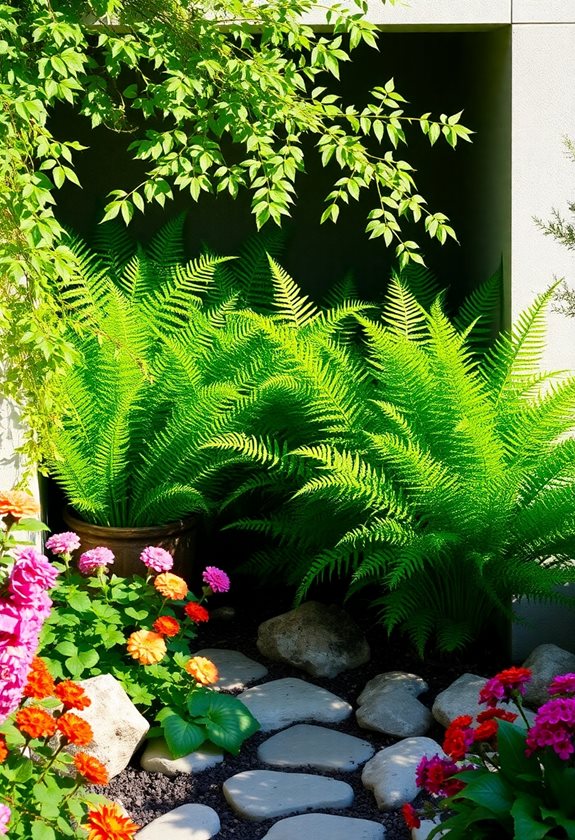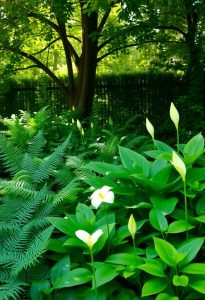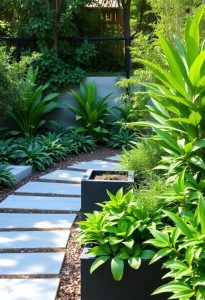Wanna add a splash of greenery to your garden? Ferns are perfect for those shady spots! Group various types like Maidenhair and Boston ferns for a lush look. They’re low-maintenance, so you won’t be a slave to watering—perfect! Think about pairing them with colorful flowers for contrast, or even use them in containers on your porch. Trust me, they can transform your space into a serene oasis. Stick around, and you’ll uncover more creative ways to showcase these beauties!
Design Highlights
- Select fern varieties suited for specific garden conditions, such as light, moisture, and soil type, to ensure healthy growth.
- Create layered groupings of ferns for a natural aesthetic, enhancing visual appeal and diversity within the garden.
- Use ferns as low-maintenance ground cover in shady areas to suppress weeds while providing lush greenery.
- Incorporate paths or seating areas among the ferns for a serene space to relax and enjoy the garden.
- Enhance biodiversity by using ferns to attract wildlife, contributing to a balanced ecosystem and improving soil health.
Selecting the Right Fern Varieties for Your Garden

When you’re diving into the world of ferns, it’s easy to get overwhelmed by the sheer variety available. You might wonder, “Which ones will thrive in my garden?” Start by considering your garden’s conditions—light, moisture, and soil type. For shaded spots, try the delicate Maidenhair fern, or for a more robust option, consider the Ostrich fern. Don’t forget to check for pests, too! You wouldn’t want those sneaky critters ruining your hard work. Additionally, incorporating ornamental grasses in your garden can complement the lush appearance of ferns beautifully. And hey, remember: each fern has its own personality, so choose ones that resonate with you. Happy fern hunting!
Creating a Fern-Centric Garden Design
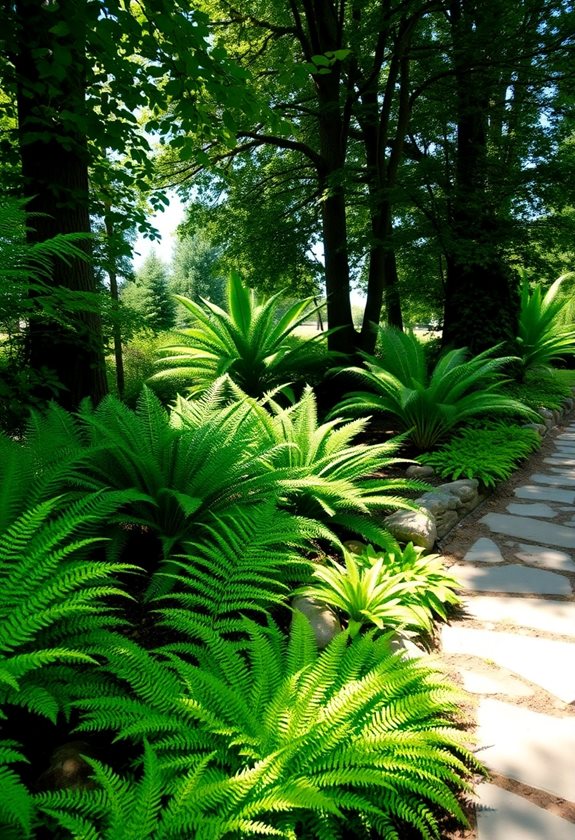
Creating a fern-centric garden design can be a delightful adventure, especially if you’re enthusiastic to transform a drab area into a lush, green oasis. Start by choosing a variety of ferns that thrive in your climate—like the hardy Boston fern or the delicate maidenhair fern. Next, layer them in groups for a natural look, mixing heights and textures. Consider adding paths or stepping stones to guide the eye and create safe walking areas. Don’t forget about incorporating seating where you can relax and enjoy your handiwork! Who wouldn’t want a cozy nook surrounded by beautiful ferns? Additionally, ferns are a versatile addition to any garden landscape, offering unique foliage that complements a variety of plants. Happy gardening!
Incorporating Ferns in Shady Areas
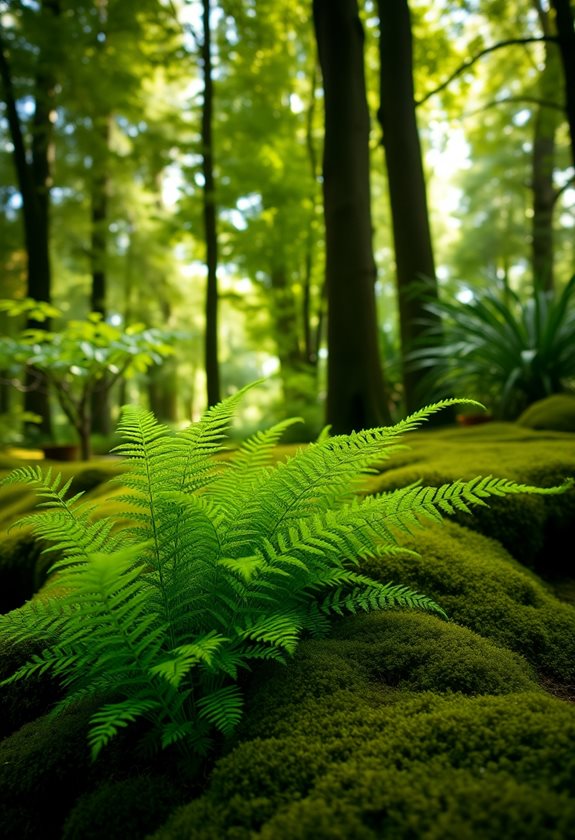
If you’ve ever looked at a shady corner of your garden and thought, “What on earth can I do with this dark spot?” you’re definitely not alone! Ferns thrive in low light, making them perfect for those tricky areas. Consider planting varieties like the lady fern or the Japanese painted fern; they add texture and color without needing direct sunlight. You can create a lush, serene space by clustering them together or lining pathways. Plus, they’re low-maintenance! Just remember to keep the soil moist, and you’ll transform that dark corner into a beautiful, green oasis. Additionally, many ferns can serve as low-maintenance ground cover that will help suppress weeds and retain soil moisture. Why not give it a try?
Pairing Ferns With Other Plants and Flowers
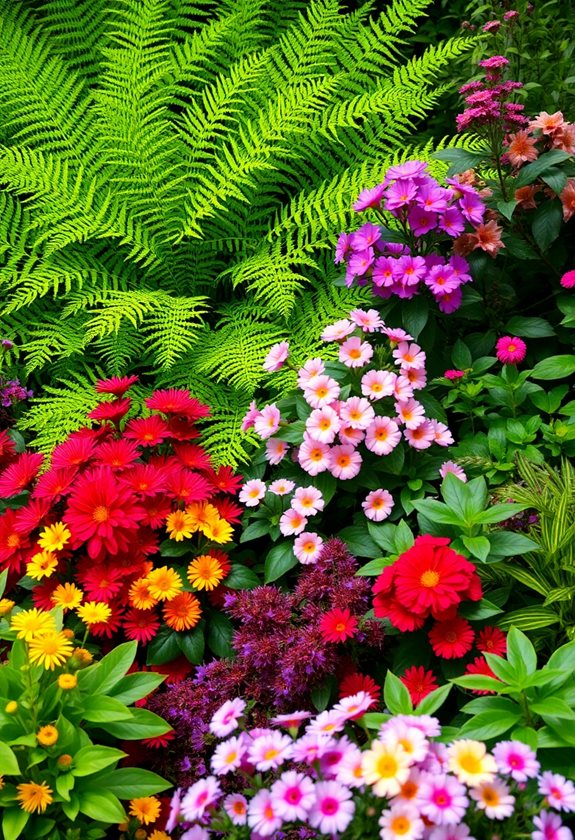
While it might seem intimidating to pair ferns with other plants and flowers, the beauty of these leafy wonders is that they can complement a wide range of garden companions! Think about mixing ferns with colorful hostas or vibrant astilbes. Their textures create a lovely contrast. You might also try pairing ferns with low-growing groundcovers like creeping thyme for a soft, layered look. Just make sure you’re considering light and moisture needs. Why not experiment? You could discover a stunning combo! Remember, gardening is all about creativity and fun, so don’t hesitate to let your personal style shine through! Happy planting! Additionally, incorporating mastering texture into your plant selection can greatly enhance the overall visual impact of your garden.
Using Ferns in Container Gardening
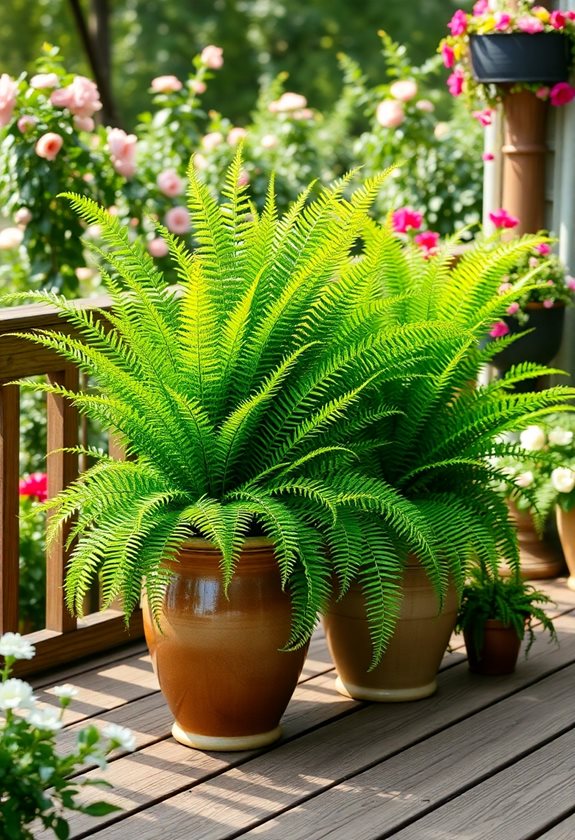
Using ferns in container gardening isn’t just a practical choice; it’s a chance to express your creativity! Imagine your porch or patio bursting with lush greenery. Here are some tips to get you started:
Transform your outdoor space into a lush oasis by incorporating ferns in beautiful containers!
- Choose the right container—make sure it has drainage holes!
- Mix different fern varieties for texture and color.
- Position your ferns in a shaded area to keep them happy.
- Water regularly, but don’t drown them—keep the soil moist.
- Add decorative stones or mulch on top for a polished look.
- Consider using eco-friendly options like coconut fiber for your containers to enhance sustainability.
With a little love and care, your fern containers can become stunning focal points in your garden!
Designing a Fern Border or Edge
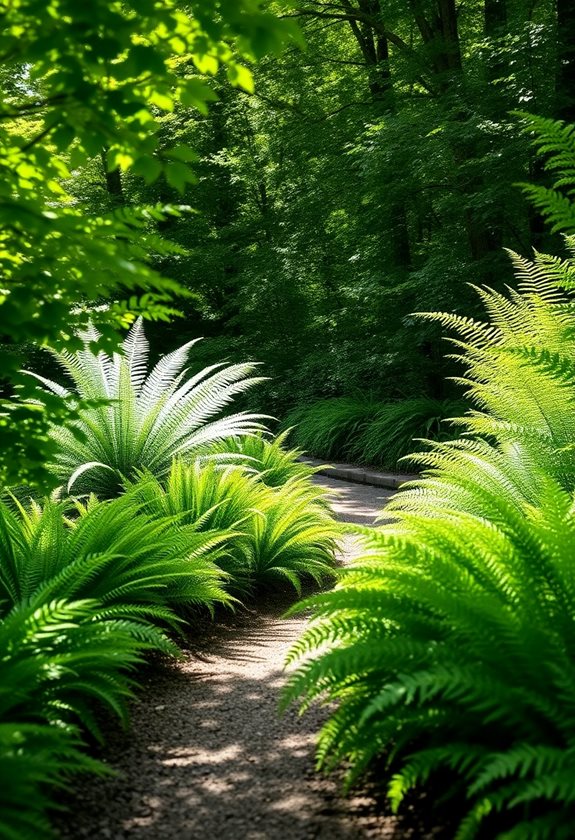
Creating a fern border or edge can add a lush, inviting feel to your garden, making it a perfect complement to those beautiful container arrangements you’ve worked so hard on. Start by choosing ferns that suit your garden’s light and moisture levels. Consider:
- Tall ferns at the back for height.
- Medium ferns in the middle for balance.
- Low-growing ferns at the front to soften the edge.
Mix textures for visual interest! Remember to leave space between them for airflow. It’s like giving your garden a cozy hug, right? Adding layering techniques can enhance the overall depth of your garden design. So, are you ready to plunge into this ferny adventure? Happy gardening!
Utilizing Ferns in Vertical Gardens
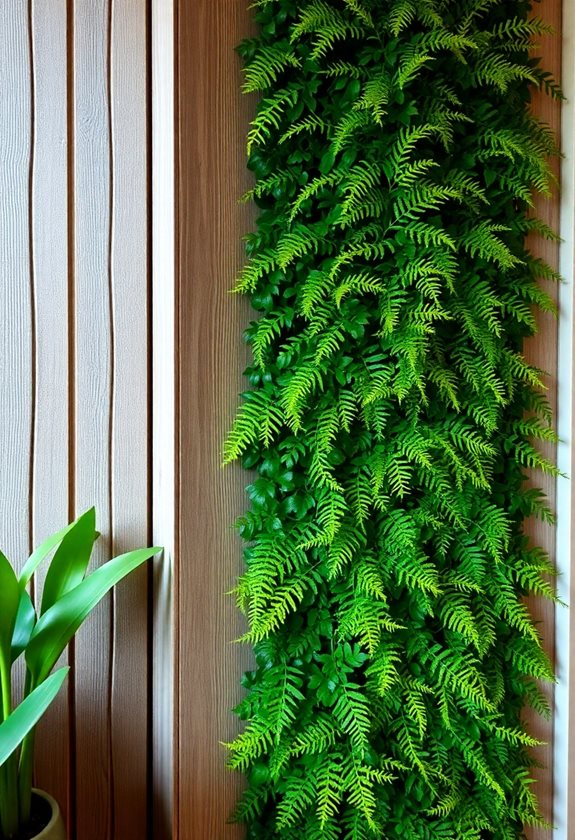
If you’ve ever dreamed of bringing a touch of greenery to your walls, then vertical gardens featuring ferns might just be your new favorite project! These lush beauties can transform any dull space into a vibrant oasis. Here are some tips to get you started:
Dreaming of green walls? Vertical gardens with ferns can turn any dull space into a vibrant oasis!
- Choose ferns that thrive in your climate.
- Use a sturdy, safe structure to support your garden.
- Guarantee adequate sunlight and moisture.
- Mix different fern varieties for texture and color.
- Regularly check for pests and maintain your ferns.
Incorporating decorative garden structures can enhance the overall aesthetic of your vertical garden. With a little effort, you’ll have a stunning vertical garden that’s not only safe but also truly enchanting!
Enhancing Water Features With Ferns
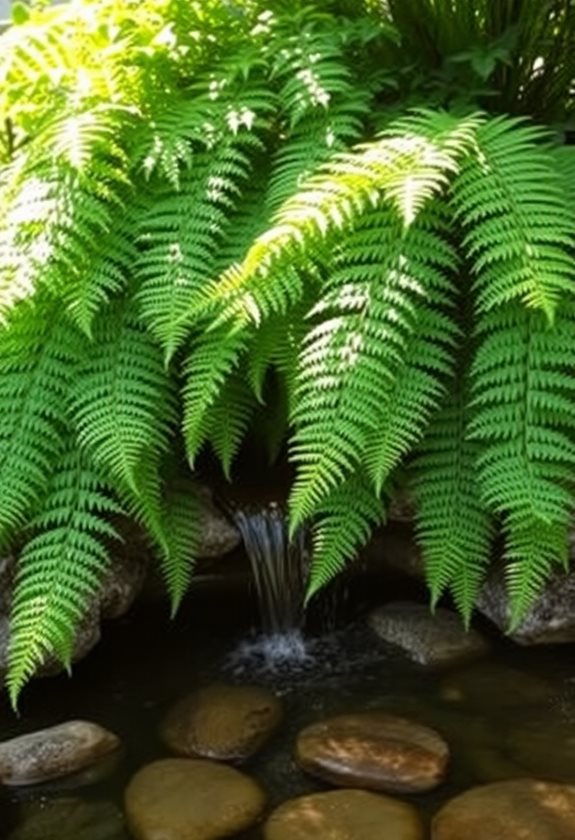
Imagine stepping into your backyard and being greeted by the soothing sound of water gently cascading over rocks, surrounded by lush, vibrant ferns. Ferns not only thrive in the moisture near water features but also create a serene atmosphere. To enhance your space, try planting ferns like the Boston fern or maidenhair fern in strategic spots around your pond or fountain. Their fronds add texture and color! You can even use container gardens filled with ferns to frame your water feature. Just remember to choose varieties that suit your climate. Incorporating water garden essentials can further elevate the beauty and functionality of your outdoor oasis. Isn’t it exciting to create such a peaceful oasis?
Seasonal Care and Maintenance of Ferns
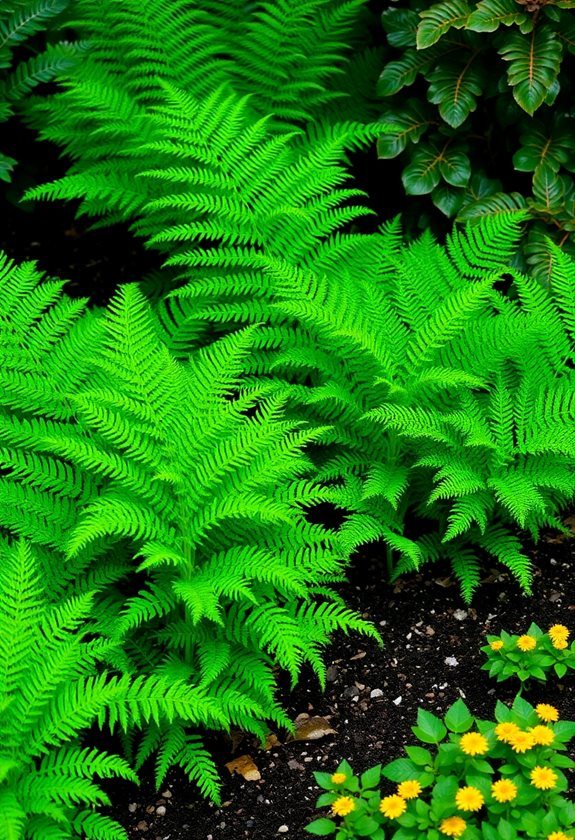
While you might think ferns are low-maintenance once you’ve planted them, they actually need some seasonal TLC to thrive in your garden. Regular care will keep your ferns lush and vibrant! Here’s what you should do:
- Trim dead fronds in early spring to encourage new growth.
- Check for pests like aphids or snails; they love ferns too!
- Water consistently, especially during dry spells—don’t let them dry out.
- Mulch around the base to retain moisture and suppress weeds.
- Fertilize lightly with a balanced fertilizer in early spring for a nutrient boost.
Incorporating low-maintenance plants into your garden design can also complement the beauty of your ferns.
With a little effort, your ferns will flourish!
The Benefits of Ferns in Biodiversity and Ecosystems
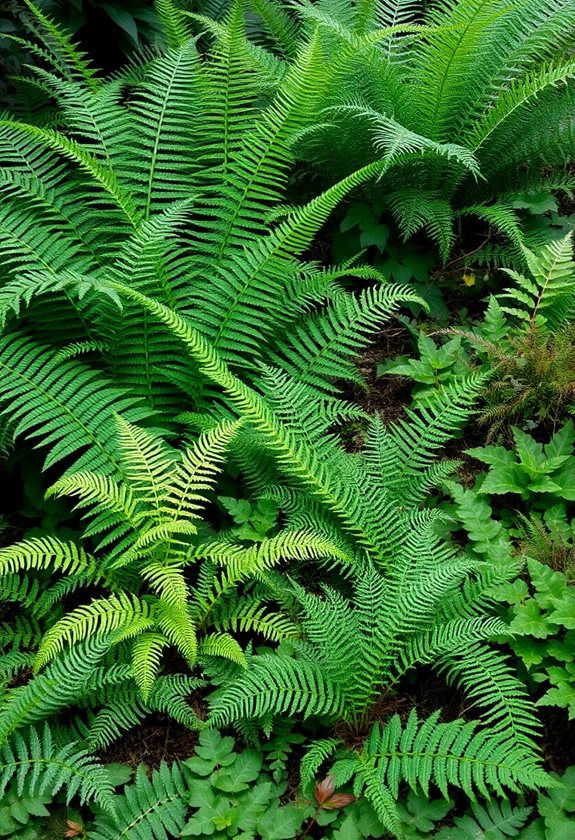
When you think about enhancing biodiversity in your garden, do ferns ever come to mind? These lush plants do more than look pretty—they play an essential role in your garden’s ecosystem! By providing habitats for insects and small wildlife, ferns can help create a balanced environment. Plus, they improve soil health by preventing erosion and retaining moisture. Ferns can also serve as lush privacy plants, providing a natural screen that enhances both beauty and seclusion in your garden.
Consider adding ferns to shady spots where few plants thrive. Not only will they flourish, but you’ll also attract diverse species. Who knew that such beautiful greenery could be a superhero for your garden’s biodiversity? Give ferns a chance; they won’t disappoint!
Frequently Asked Questions
How Do Ferns Impact Soil Health in Gardens?
Ever wondered how ferns work their magic on soil health? These green wonders help retain moisture, making your garden thrive! Their leaves break down and enrich the soil with nutrients. Plus, they prevent erosion—who wouldn’t want that? When you plant ferns, you’re not just beautifying your space; you’re creating a healthier environment for other plants. So, why not give them a try and watch your garden flourish? You’ll love the results!
Can Ferns Attract Beneficial Insects to the Garden?
Ferns can attract beneficial insects like ladybugs and lacewings, which love to munch on pests. When you plant ferns, you create a lush habitat that encourages these helpful critters. They appreciate the shade and moisture ferns provide. Plus, the diverse foliage can offer shelter. So, why not create a cozy nook for these garden allies? Your plants will thank you, and you’ll enjoy a healthier garden ecosystem! Happy gardening!
Are Ferns Safe for Pets and Children?
You’ve probably heard, “Curiosity killed the cat,” but when it comes to ferns, curiosity can be a good thing! Ferns are generally safe for pets and kids, but it’s wise to keep an eye on them. While most ferns aren’t toxic, some can cause mild stomach upset if ingested. Always check specific types before planting. Remember, a little caution goes a long way in creating a safe and beautiful garden for everyone!
How Do I Propagate Ferns for My Garden?
Want to propagate ferns? It’s easier than you think! Start by dividing the root clumps in early spring. Just dig them up, separate the roots, and replant them in moist soil. You can also use spores! Collect them from the underside of mature fronds, sprinkle them on soil, and keep it damp. Exciting, right? With a little patience, you’ll have a lush fern collection in no time. Happy gardening!
What Common Pests Affect Ferns and How Can I Prevent Them?
Imagine your ferns are like a protective shield in your garden, but pests can sneak in like uninvited guests! To keep them safe, check for aphids or slugs. You can prevent these pests by:
- Keeping the area clean and debris-free.
- Using insecticidal soap or water sprays—just mix a little soap with water!
- Encouraging beneficial insects like ladybugs.
Stay vigilant, and your ferns will thrive, making your garden a peaceful retreat!

